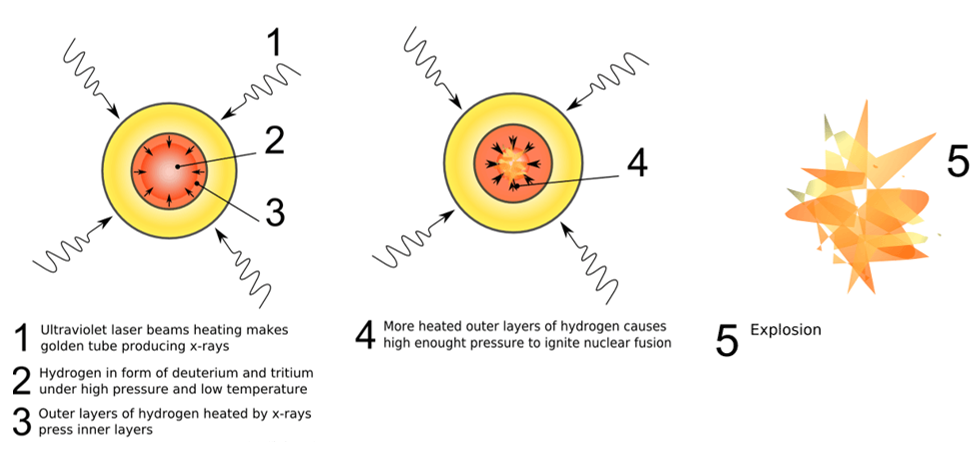|
Nuclear Fusion
 It is the process of generating energy by melding together light atoms. Alternatively, it can be referred to as a reaction in which multiple atomic nuclei come close enough to form one or more different atomic nuclei and subatomic particles (neutrons or protons). The difference in mass between the reactants and products is manifested as the release of large amounts of energy. Refer the diagram below, for e.g. fusion of deuterium with tritium creating helium-4, freeing a neutron, and releasing 17.59 MeV as kinetic energy of the products while a corresponding amount of mass disappears, in agreement with kinetic E = Δmc^2, where Δm is the decrease in the total rest mass of particles.[i] It is the process of generating energy by melding together light atoms. Alternatively, it can be referred to as a reaction in which multiple atomic nuclei come close enough to form one or more different atomic nuclei and subatomic particles (neutrons or protons). The difference in mass between the reactants and products is manifested as the release of large amounts of energy. Refer the diagram below, for e.g. fusion of deuterium with tritium creating helium-4, freeing a neutron, and releasing 17.59 MeV as kinetic energy of the products while a corresponding amount of mass disappears, in agreement with kinetic E = Δmc^2, where Δm is the decrease in the total rest mass of particles.[i]
Source: By Wykis - Own work, Public Domain
A fusion process that produces a nucleus lighter than iron-56 or nickel-62 will generally yield a net energy release.
Methods for Achieving Fusion. The major methods of achieving fusion are:
- Thermonuclear Fusion. Extremely high temperatures are required to achieve thermonuclear fusion. This type of fusion is of two types i.e., uncontrolled fusion, wherein the resulting energy is released in an uncontrolled manner, for e.g. hydrogen bombs and controlled fusion, wherein the fusion reactions take place in an environment allowing methodical release of energy for intended purposes such as power generation.
- Initial Confinement Fusion. This type of fusion is achieved by raising the temperature of the fusion fuel (hydrogen isotopes) to hundreds of millions of degrees. The tiny capsules of fuel are crushed with intense laser beams or magnetic field pulses to produce the hot and dense plasma. This plasma is similar to that which would be produced in a Hydrogen Bomb. Therefore, when explosive testing is not feasible due to various treaties on the subject, this type of fusion becomes important in understanding the nuclear bombs.
- Inertial Electrostatic Confinement. As the name suggests, electric fields are used to heat up the ions or electrons to create the plasma. Typical magnetic confinement fusion plasma is 15 keV, or 170 megakelvin. An ion with a charge of one can reach this temperature by being accelerated across a 15,000 V drop[ii]. The inertial electrostatic confinement method has not been found to be practical to achieve the desired energy levels.
- Beam-Beam or Beam-Target Fusion. Accelerators are used to accelerate one or both the nuclei to produce the energy required to initiate the reaction. If only one nuclei is accelerated it is referred to as beam-target fusion however if both nuclei are accelerated, it is called a beam-beam fusion. This type of fusion is not very efficient.
- Muon-Catalysed Fusion(µCF). This type of fusion employs muons (unstable subatomic particles similar to electrons). However, the energy required to produce muons is far greater than the resultant fusion energy and therefore is not a feasible method for fusion.
Feasibility & Practicality
In certain scientific quarters, it is firmly believed that fusion is going to be the chief (and may be the only) source of energy on earth in the future. In light of this, the two aspects of feasibility and practicality have been at the root of all types of research undertaken by scientists globally. As discussed above, if controlled fusion is to be achieved, currently the only feasible and practical method is Initial Confinement Fusion also known as Laser Fusion.
Laser Fusion
- Principle. Laser fusion involves hydrogen fuel consisting of Deuterium and Tritium encased in a golden tube. The principle of laser fusion is explained diagrammatically as under[iii]

This is quite similar to the explosion of a fission-fusion bomb, with an added advantage of having it under control and without the attendant destruction inflicted by the bomb.
- Military Implications
-
- Simulation of Hydrogen Bomb. In light of various international agreements and restrictions on testing a nuclear device, Laser Fusion provides an excellent alternative to an actual hydrogen bomb test. Various parameters of an intended hydrogen bomb can be modelled employing laser fusion.
- Production of Fissile Material. The laser fusion reactors can also be used to produce fissile material. Giorgio Franceschini, Matthias Englert& Wolfgang Liebert in their article in The Non Proliferation Review argue that[iv]
- Tritium Diversion. There is also a possibility of diverting Tritium! As the Tritium is constantly being consumed (lesser amount) and produced (much larger amount) in a laser fusion reactor; small quantities can always be diverted to be used in a fission bomb to significantly boost its ‘yield to weight’ ratio. The main rationale for tritium within a nuclear fission weapon is to increase its yield with an intelligent coupling of nuclear fission (involving plutonium or uranium) and nuclear fusion (involving deuterium and tritium)[v].
- Miniaturised Fusion Reactors for Missiles/Spacecrafts and Aircrafts. Starting from 1950s there have been several projects undertaken by the USA to produce nuclear reactors to power up various airborne systems. These included Projects Pluto (Nuclear Powered Ramjet Engines for Cruise Missiles), Nuclear Engine for Rocket Vehicle Applications (NERVA), Orion (Spacecrafts to be propelled by Hydrogen Bombs) to name a few. Currently Russia has claimed to have successfully tested a cruise missile having nuclear propulsion capabilities. In President Putin’s own words “Russia’s advanced arms are based on the cutting-edge, unique achievements of our scientists, designers, and engineers. One of them is a small-scale, heavy-duty nuclear energy unit that can be installed in a missile like our latest X-101 air-launched missile or the American Tomahawk missile—a similar type but with a range dozens of times longer, dozens—basically an unlimited range. It is a low-flying stealth missile carrying a nuclear warhead, with almost an unlimited range, unpredictable trajectory and ability to bypass interception boundaries. It is invincible against all existing and prospective missile defence and counter-air defence systems”[vi].
However, a fusion reactor has not been developed till now to achieve fusion propulsion capabilities.
- Major Fusion Reactor Facilities. National Ignition Facility at the Lawrence Livermore National Laboratory in California, USA and International Thermonuclear Experimental Reactor (ITER) in France are the two major facilities working on fusion energy. ITER is a multibillion euro joint venture funded by the European Union, the United States, Japan, Russia, China, South Korea, and India. The ITER project foresees the construction of a larger-scale 500 megawatt experimental reactor which is viewed as a first step toward the long-term goal of commercial fusion power. It will be followed by a series of demonstration reactors (DEMO) in the 2030s and beyond. If ITER and DEMO prove that fusion power generation is both technologically and economically viable, the first commercial fusion power plants could go online by the middle of the twenty-first century[vii].
- Latest Developments. The Colorado State University (CSU) has employed nano wires to achieve micro scale nuclear fusion in their laboratory[viii]. The CSU team of scientists have developed an ultra fast, high-powered tabletop laser from scratch. A pulsed laser is employed to irradiate a target of invisible wires and instantly create extremely hot, dense plasmas—with conditions approaching those inside the sun. These plasmas drive fusion reactions, giving off helium and flashes of energetic neutrons. The process is explained pictorially as under:

Top left: A scanning electron microscope image of aligned deuterated polyethylene nanowires. The other panels are 3-D simulations of the nanowires rapidly exploding following irradiation by an ultra-intense laser pulse. Credit: Advanced Beam Laboratory/Colorado State University
Conclusion
Nuclear Fusion is considered to be the future of energy for the habitants of planet Earth with associated military applications. However, scientists remain a long way from what's known as ignition: the point at which fusion of any kind releases more energy than was consumed to start it. Therefore, except for the modelling and production of fissile material on the side, fusion reactors with current trends are unlikely to be weaponised in the short to midterm of next three to four decades.
|
References
[i]By Wykis - Own work, based on w:File:D-t-fusion.png, Public Domain, https://commons.wikimedia.org/w/index.php?curid=2069575
[ii]https://en.wikipedia.org/wiki/Inertial_electrostatic_confinement
[iii]Martin Šrubař , http://fusion.srubar.net/laser-fusion.html
[iv]Giorgio Franceschini, Matthias Englert& Wolfgang Liebert (2013) Nuclear Fusion Power for Weapons Purposes, The Nonproliferation Review, 20:3, 525-544, DOI: 10.1080/10736700.2013.852876, pp543
[vi]Best bad idea ever? Why Putin’s nuclear-powered missile is possible…and awful,Sean Gallagher, 22 Mar 2018
https://arstechnica.com/science/2018/03/best-bad-idea-ever-why-putins-nuclear-powered-missile-is-possible-and-awful/
[viii]Laser-heated nanowires produce micro-scale nuclear fusion with record efficiency (2018,March 14) retrieved 3 May 2018 from https://phys.org/news/2018-03-laser-heated-nanowires-micro-scalenuclear-fusion.html
|



